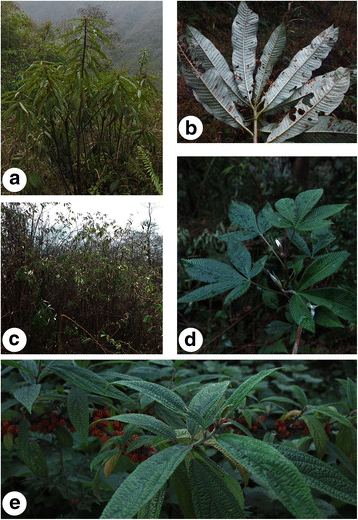Prioritizing fodder species based on traditional knowledge: a case study of mithun (Bos frontalis) in Dulongjiang area, Yunnan Province, Southwest China
- PMID: 28472968
- PMCID: PMC5418811
- DOI: 10.1186/s13002-017-0153-z
Prioritizing fodder species based on traditional knowledge: a case study of mithun (Bos frontalis) in Dulongjiang area, Yunnan Province, Southwest China
Abstract
Background: Livestock rearing is one of the oldest and most important types of smallholder farming worldwide. The sustainability of livestock production depends on the efficient utilization of locally available resources. Some traditional methods of raising livestock may offer valuable lessons in this regard. This study documented and evaluated local knowledge of wild forage plants in the Dulongjiang area in Southwest China in the context of rearing mithun (Bos frontalis) in order to provide a sound evidence base for tree fodder selection and the establishment of integrated tree-crop-livestock systems.
Methods: The snowball technique was used to identify key informants with specific knowledge about the topic. Free listing and semi-structured interviews were conducted with 58 households. Participatory investigation and transit walks were used to investigate potential fodder species. Ethnobotanical information was collected, documented and organized.
Results: Overall, 142 wild forage plants from 58 families and 117 genera were identified. Species of the Poaceae, Rosaceae and Urticaceae families were most abundant, with 16, 14 and 11 species respectively identified as fodder plants. Our results indicated that tree/shrub forage plays a major role in the diet of mithun, unlike that of other ruminants. Mithun prefers to browse and move around the forest in search of food, particularly rough and even barbed leaves. Tree species like Debregeasia orientalis, Saurauia polyneura and Rubus species were identified as being important fodder sources. Farmers in this area have traditionally relied on common property resources such as community-managed forests and grasslands to feed their livestock. Farmers have strong incentive to raise mithuns rather than other livestock species due to Dulong people's cultural preferences.
Conclusions: The wide variety of plants cited by the informants demonstrate the importance of traditional knowledge in gathering information about forage resources. This diversity also offers the prospect of identifying promising species which could be used as fodder plants. Identifying such species and tree fodder species in particular could help smallholder farmers to integrate trees, livestock and crops as part of a sustainable farming system.
Keywords: Dulong people; Mithun; Traditional knowledge; Tree fodder; Wild fodder plants.
Figures






Similar articles
-
Nutrient value of wild fodder species and the implications for improving the diet of mithun (Bos frontalis) in Dulongjiang area, Yunnan Province, China.Plant Divers. 2020 Oct 2;42(6):455-463. doi: 10.1016/j.pld.2020.09.007. eCollection 2020 Dec. Plant Divers. 2020. PMID: 33733013 Free PMC article.
-
Ethnobotanical study on wild edible plants used by Dulong people in northwestern Yunnan, China.J Ethnobiol Ethnomed. 2022 Jan 21;18(1):3. doi: 10.1186/s13002-022-00501-3. J Ethnobiol Ethnomed. 2022. PMID: 35062974 Free PMC article.
-
Ethnobotanical studies of fodder grass resources for ruminant animals, based on the traditional knowledge of indigenous communities in Central Punjab Pakistan.J Ethnobiol Ethnomed. 2017 Oct 4;13(1):56. doi: 10.1186/s13002-017-0184-5. J Ethnobiol Ethnomed. 2017. PMID: 28978348 Free PMC article.
-
Ethnobotanical profiles of wild edible plants recorded from Mongolia by Yunatov during 1940-1951.Hist Philos Life Sci. 2021 Aug 11;43(3):100. doi: 10.1007/s40656-021-00428-0. Hist Philos Life Sci. 2021. PMID: 34382157 Free PMC article. Review.
-
A systematic review on the ethnoveterinary uses of mediterranean salt-tolerant plants: Exploring its potential use as fodder, nutraceuticals or phytotherapeutics in ruminant production.J Ethnopharmacol. 2021 Mar 1;267:113464. doi: 10.1016/j.jep.2020.113464. Epub 2020 Oct 10. J Ethnopharmacol. 2021. PMID: 33049342
Cited by
-
Nutrient value of wild fodder species and the implications for improving the diet of mithun (Bos frontalis) in Dulongjiang area, Yunnan Province, China.Plant Divers. 2020 Oct 2;42(6):455-463. doi: 10.1016/j.pld.2020.09.007. eCollection 2020 Dec. Plant Divers. 2020. PMID: 33733013 Free PMC article.
-
A Biocultural Study on Gaoligongshan Pig (Sus scrofa domesticus), an Important Hog Landrace, in Nujiang Prefecture of China.Biology (Basel). 2022 Nov 2;11(11):1603. doi: 10.3390/biology11111603. Biology (Basel). 2022. PMID: 36358304 Free PMC article.
-
Ethnobotanical study on wild edible plants used by Dulong people in northwestern Yunnan, China.J Ethnobiol Ethnomed. 2022 Jan 21;18(1):3. doi: 10.1186/s13002-022-00501-3. J Ethnobiol Ethnomed. 2022. PMID: 35062974 Free PMC article.
-
Diversity and traditional knowledge concerning fodder plants are invaluable assets for enhancing the sustainable management of crop-livestock system of Zhaotong City in the mountainous southwest China.Plant Divers. 2024 Oct 5;47(2):311-322. doi: 10.1016/j.pld.2024.09.011. eCollection 2025 Mar. Plant Divers. 2024. PMID: 40182477 Free PMC article.
-
Changes in traditional ecological knowledge of forage plants in immigrant villages of Ningxia, China.J Ethnobiol Ethnomed. 2019 Dec 16;15(1):65. doi: 10.1186/s13002-019-0333-0. J Ethnobiol Ethnomed. 2019. PMID: 31842902 Free PMC article.
References
-
- Neo H, Chen L. Household income diversification and the production of local meat: The prospect of small-scale pig farming in southern Yunnan, China. Area. 2009;41(3):300–9. doi: 10.1111/j.1475-4762.2008.00873.x. - DOI
-
- Tilt B. The struggle for sustainability in rural China: Environmental values and civil society. New York: Columbia University Press; 2013.
-
- Schneider M. Feeding China’s pigs: Implications for the environment, China’s smallholder farmers and food security. Minneapolis: Institute for Agriculture and Trade Policy; 2011.
-
- Fu Y, Guo H, Chen A, Cui J. Household differentiation and on-farm conservation of biodiversity by indigenous households in Xishuangbanna, China. Biodivers Conserv. 2006;15(8):2687–703. doi: 10.1007/s10531-005-6318-4. - DOI
MeSH terms
LinkOut - more resources
Full Text Sources
Other Literature Sources

